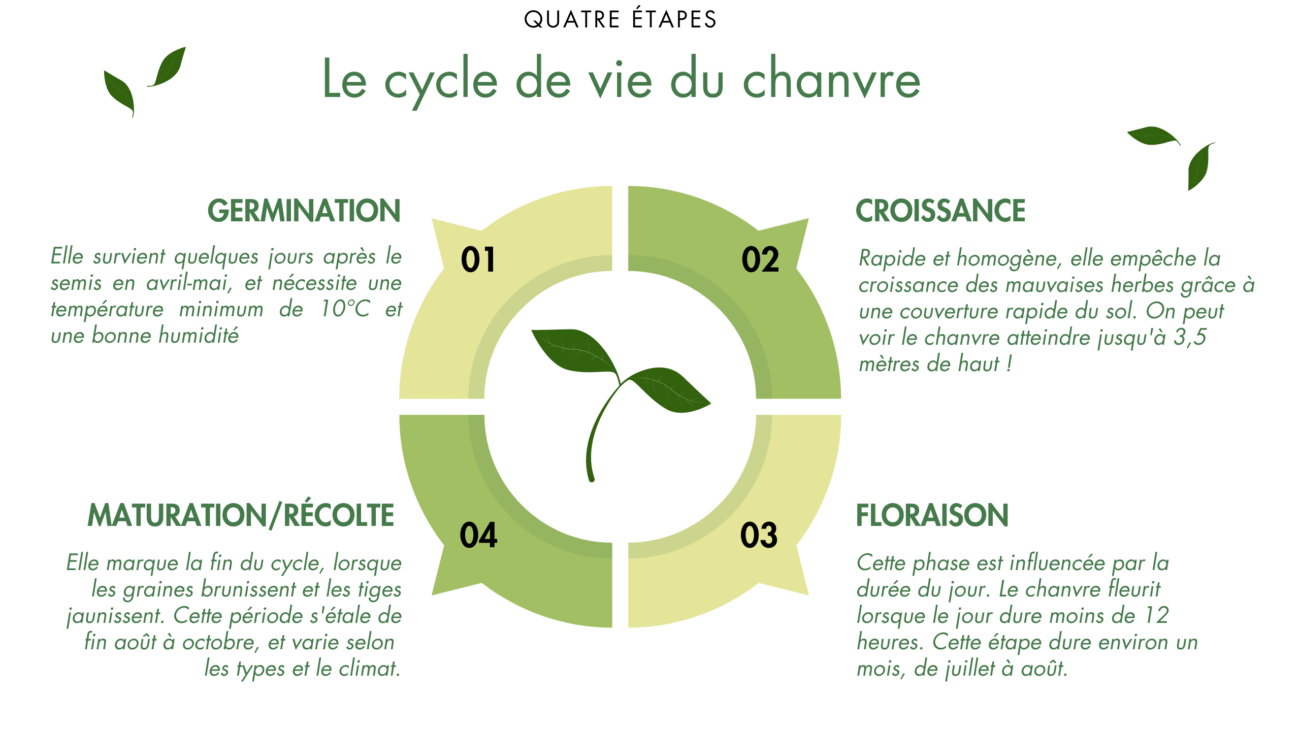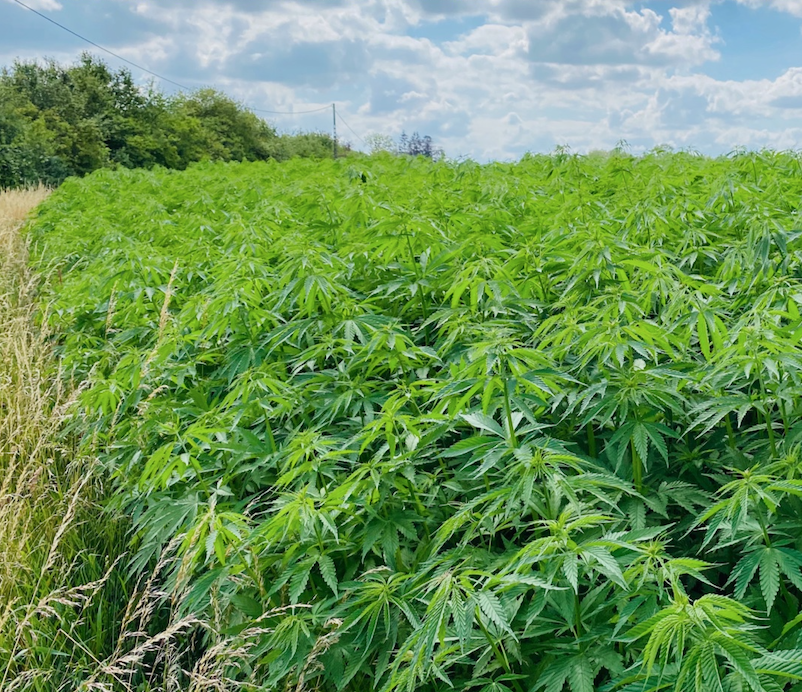Although long stigmatised, hemp is back in the agricultural spotlight as a versatile crop with multiple applications. From construction and food to textiles and skincare products, the plant is attracting growing interest for its medicinal, ecological and economic properties. Perhaps you're wondering how to get started growing hemp? This article will answer a number of questions. What are the essentials for a successful crop? How do you go about managing and maintaining a hemp field? What are the prospects and challenges for the industry? You'll find all the information you need to know about growing hemp.
Understanding the specific characteristics of the hemp plant
Hemp, a member of the Cannabaceae family like hops and mulberries, comes in many varieties. These differ in morphology, chemical composition and use. They can be grouped into three main categories: fibre hemp, grain hemp and CBD hemp.
The different uses of hemp
- For its fibres cultivated for its stalks, which are rich in long, strong fibres. is applied to the creation of textiles, paper, ropes and building materials. Hemp must have a THC content below 0.2% and CBD below 1%. Farmers sow it densely and harvest it before the end of the year. flowering.
- For its seeds its nutritious seeds are rich in protein, essential fatty acids (omega-3 and omega-6), vitamins and minerals. The seeds are used forhuman food and animal feed, as well as producing oil, flour and sugar. biofuel. With a THC content of no more than 0.2% and a CBD content ranging from 1 to 5%, it is grown at longer intervals and harvested after flowering.
- For its flowers Hemp is used for flowers rich in cannabidiol (CBD), renowned for its potential therapeutic properties. Sown very sparsely, it harvest at full maturity. Legal in BelgiumCBD flowers have a low THC concentration (below 0.2%) and a high high CBD content (5 to 20%).
The life cycle of hemp
Hemp is an annual plant that grows life cycle in one season and lasts between 100 and 150 days, depending on the variety. Its development includes four stages keys :

- the germination It occurs a few days after sowing in April-May, and requires a minimum temperature of 10°C and good humidity.
- the growth Cultivation: This is the most impressive stage. Fast and even, it prevents weeds from growing thanks to rapid ground cover. Hemp can grow up to 3.5 metres high! Its rapid growth also requires a substantial supply of water and nitrogen.
- the flowering Flowering: This phase is influenced by the length of the day. Hemp flowers when the day lasts less than 12 hours. This stage lasts about a month, from July to August.
- the maturation Harvesting: This marks the end of the cycle, when the seeds turn brown and the stems turn yellow. This period runs from late August to October, and varies according to type and climate.
Each of these steps is essential to obtain quality hemp that respects our values and the environment.environment.
Ideal climatic conditions for growing hemp
Hemp is hardy and adapts well to different soils and climates. However, it will develop all the faster if the soil is well adapted. heat and light. It thrives at temperatures of between 15 and 27 degrees Celsius during the growing season. Temperatures that are too hot or too cold can adversely affect its growth. growth.
La Belgium is temperate oceanic climateThe climate is influenced by both the North Sea and the Atlantic Ocean, resulting in moderate summers and winters. These weather conditions are generally favourable to hemp cultivation :
- Sunshine Hemp: Hemp can be grown in Belgium during the spring and summer seasons, when temperatures are warmer and days longer, favouring its development. Although Belgium can be particularly prone to cloudy days, it generally receives enough sunshine (at least 6 to 8 hours a day on average) to support the growth of hemp.
- Humidity Hemp: Sensitive to drought and excess water, an adjusted water supply is crucial. Hemp does quite well during long periods without rain, but on the other hand, it hates having its feet in water!
In short, the Belgian climate generally offers favourable conditions to hemp growing, although other factors such as soil quality and cultivation practices also play a crucial role in the success of the crop.
What you need to start growing hemp
To grow hemp successfully, it is essential to address a number of fundamental aspects. These include: preparing the soil, choosing the optimum sowing period, and complying fully with all the relevant legal and regulatory requirements.
Soil preparation and nutrient requirements
The secret to a successful harvest? Understanding the needs of our beloved plants right from the start!



Before plunging the seeds into the soil, it is crucial that you prepares the ground for a successful harvest. A soil analysis will provide valuable information about its composition, pH and nutrient levels.
- Hemp needs a deep soil, fertilewell drained and carefully structured. What's more, the ideal soil pH for growing hemp is between 6.0-7.0.
If our soil is too acidic (pH below 7), adding lime can help restore a balanced pH, which will encourage plant growth. On the other hand, if the soil is too alkaline (pH above 7), adding organic matter such as compost can help to acidify it naturally.
- We also need to ensure that our plants have nutrients necessary for a optimal growth. Hemp, like any other crop, has its own specific needs. Nitrogen, phosphorous and potassium play crucial roles in its development.
Nitrogen is essential for protein formation, which promotes vigorous leaf and stem growth.
Phosphorus is necessary for root formation and flower development.
Potassium helps to strengthen the structure of plants and improve their resistance to disease and environmental stress.
These elements can be found in large quantities, for example, in manures cattle, in poultry droppings or in digestate from biomethanisation.
Choosing the right time to sow hemp
Hemp, a spring plant, is typically sown in April-May, once the soil temperature has reached 10°C, to avoid the risk of late frost and ensure optimum development. Visit sowing must be carried out with precision, using a suitable seed drill, respecting the ideal density and depth according to the variety and production objective. It's crucial to ensure rapid lifting and regular production of hemp, maintaining wet soil and avoiding the formation of crusts.
The regulatory and legal steps you need to know about to grow hemp
Growing hemp requires knowledge and experience. respect scrupulous current regulations. This means using only varieties with a THC content under the limit of 0.2 % and listed in the official catalogue. A declaration of your crop to the competent authoritiesby specifying information such as the variety usedthe cultivated area and the planned use of hemp, is also compulsory. In addition, compliance with agricultural practices Avoiding cross-contamination with other cannabis varieties and keeping a record of seed and finished product transactions is essential.
Managing and maintaining a hemp crop
After planting, you need to monitor the growth of the hemp and protect it from weedsdiseases and pests. It is also essential to carefully plan harvesting and storage. hemp processingdepending on the intended end use. Here are some recommendations for effective management and maintenance of your hemp crop.
Cultivation practices specific to hemp
Hemp is distinguished by its minimal need foragricultural operations thanks to its natural ability to occupy space quickly and suppress weeds. It generally requires no chemical or mechanical weeding, except where weeds are abundant. Similarly fungicide treatments or insecticides are unnecessary in most cases, thanks to the natural resistance of hemp. A suitable irrigation during the growing season is crucial in preventing water stress. It is also advisable to crop rotationThis means that hemp should not be grown on the same plot of land more than once every four years, in order to preserve the quality of the soil. soil fertility and reduce the risk of illness.
Combating weeds, diseases and parasites
Despite its natural resistance, hemp can be affected by certain weeds, diseases and parasites.
- Weeds, especially perennials, can be a real threat. Good weed control soil preparation and a density of sowing The right soil cover limits their development.
- Against diseasesopt for resistant varietiesIt is important to be aware of the symptoms of the disease, practise crop rotation and monitor for the appearance of symptoms.
- As for parasitesAlthough they are less attracted to hemp, monitoring is necessary to detect the presence of hemp. slugsAphids and other pests in good time. In the event of a serious infestation, you can consider appropriate treatments, always in compliance with authorised standards.
Harvesting and processing hemp
The harvesting and processing process varies depending on whether hemp is destined for fibre production, from seeds or of CBD flowers. In the case of fibre, harvesting takes place before flowering, followed by a period of retting on the ground, then collected for processing into products such as textile or paper. The seeds, harvested when ripe, are then carefully sorted and stored before being transformed into oilflour or biofuel. Hemp grown for its CBD flowers is harvested when fully ripe so that the flowers contain an optimal level of CBD, then dried and processed to produce oils, creams and other products. CBD-based products.
Conclusion
Hemp stands out for its exceptional qualities, and offers sustainable alternatives and innovative solutions in theagricultureindustry and health. To start growing hemp, it's essential to understand its unique characteristics, the conditions required for it to grow well, and the best way to grow it. appropriate growing techniques. It's also crucial to comply with existing legislation governing the production and processing of hemp. If you're interested in growing hemp, take the time to find out more from professionals in the field, who can offer support and advice for your project. Considered a promising crop, hemp is well worth exploring.
Discover our food range made from Belgian hemp and our CBD oilsTake advantage of the benefits of hemp right now!



